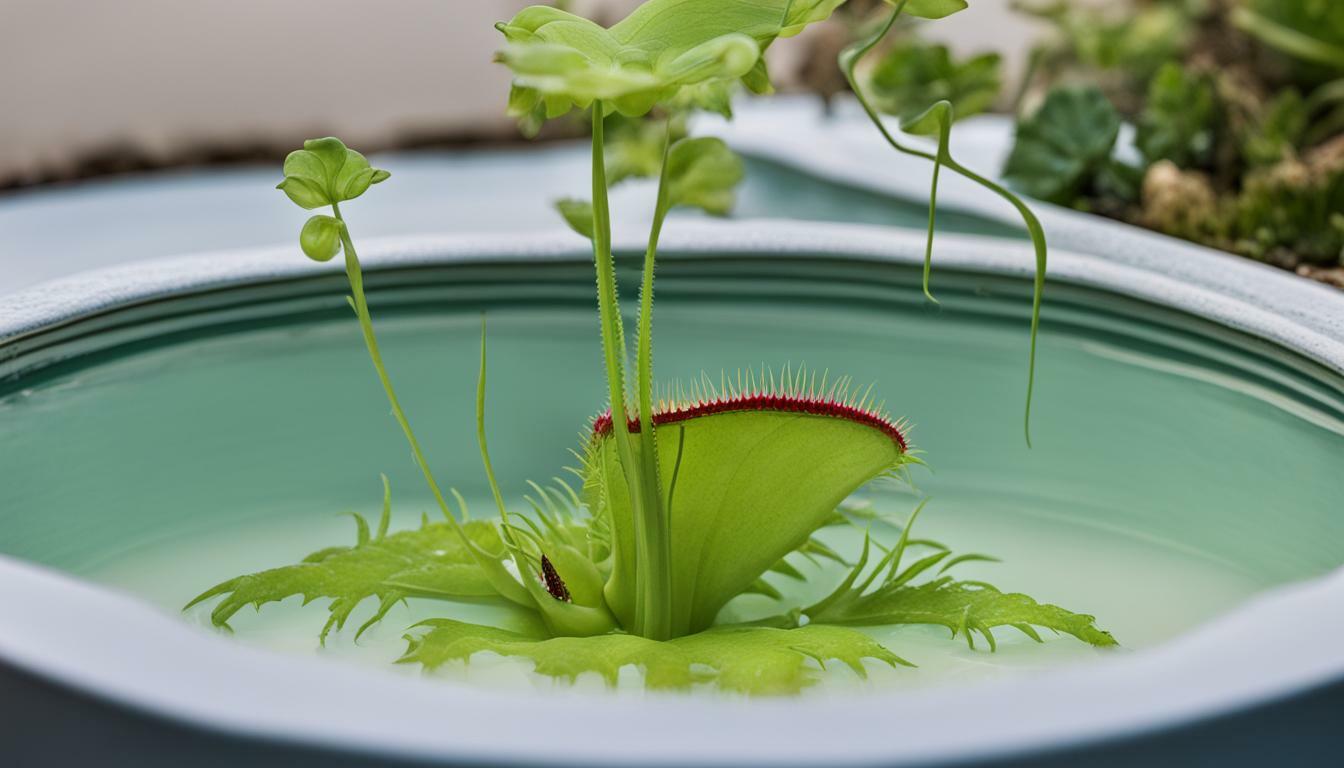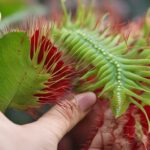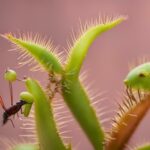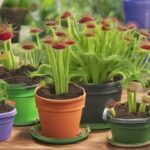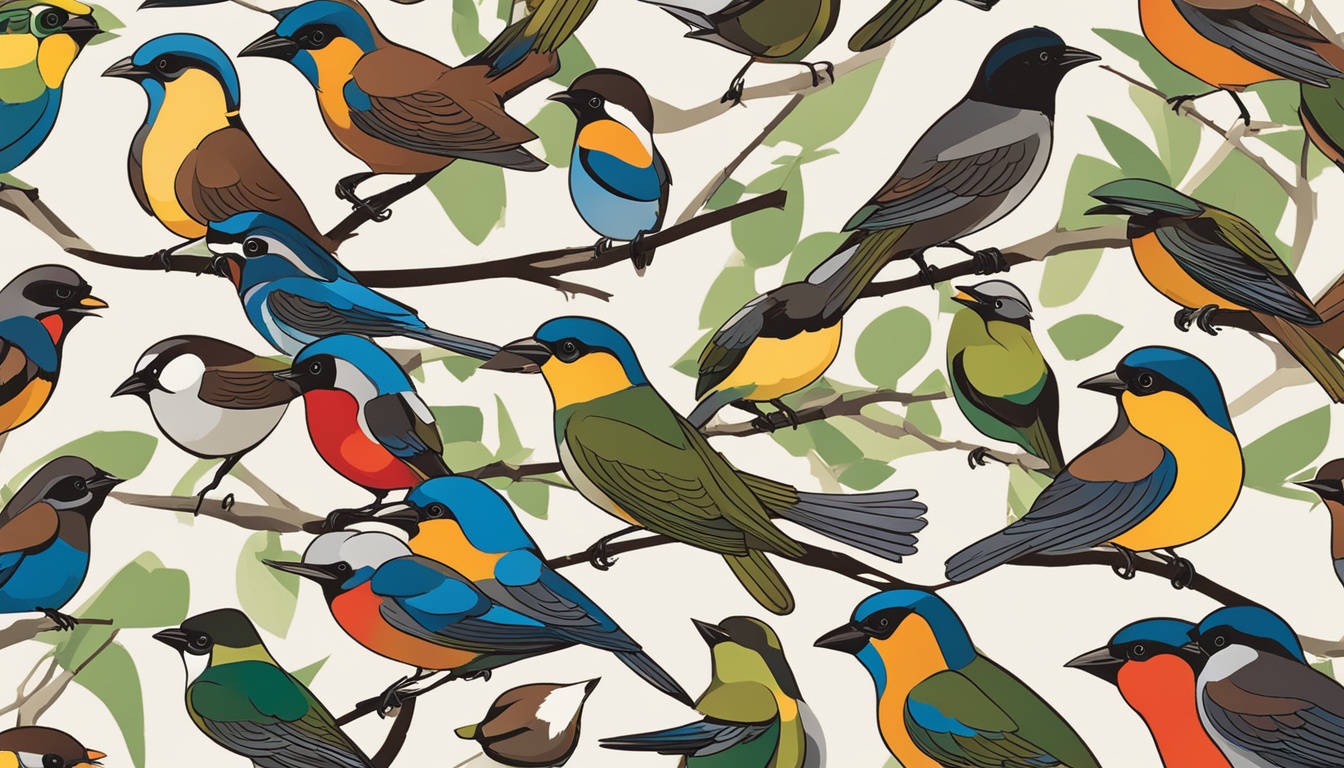As a Venus flytrap owner, you want to make sure your plant is healthy and thriving. Water is an essential element for any plant’s growth, but is it safe to let your Venus flytrap sit in water? In this section, we will explore the care requirements of Venus flytraps and the role of water in their growth and health to answer your question.
Key Takeaways:
- Proper watering is crucial for Venus flytrap care.
- Waterlogged soil can harm or even kill Venus flytraps.
- Venus flytraps require a balance of soil moisture and hydration to thrive.
Understanding Venus Flytrap Care and Soil Moisture
Proper care is crucial for the survival and thriving of your Venus flytrap. Soil moisture plays a vital role in its well-being.
Venus flytraps need moist soil, but it is important to avoid waterlogging. The preferred soil type is a mix of sphagnum moss and perlite.
| Watering Practices | Notes |
|---|---|
| Watering Frequency | Venus flytrap requires frequent watering, but the soil should not remain wet or soggy for an extended period. |
| Watering Amount | Water your Venus flytrap thoroughly until excess water drains out of the pot’s bottom. |
| Proper Drainage | The pot must have proper drainage to prevent waterlogging, which can harm your Venus flytrap. |
Overwatering or letting your Venus flytrap sit in water can cause it to drown. It is crucial to ensure proper drainage and avoid letting the plant sit in water for an extended period. Excess moisture can lead to root rot and other problems.
Maintaining a balance between soil moisture and hydration levels is essential for the healthy growth of your Venus flytrap. By following proper watering practices, you can provide your plant with the necessary moisture to thrive.
Can Venus Flytraps Survive in an Aquatic Habitat?
As a Venus flytrap owner, you may wonder if your plant can survive in an aquatic habitat, given its natural swampy environment. While Venus flytraps require moist soil, they are not adapted to survive in standing water. In fact, prolonged exposure to water can be detrimental to their health and may cause root rot.
While Venus flytraps can grow in a terrarium or other enclosed environment, it is essential to provide proper care and avoid overwatering. In their natural habitat, Venus flytraps grow in sandy soils with low nutrient levels – a far cry from the nutrient-rich aquatic environments. Therefore, it is necessary to simulate their natural habitat by using an appropriate soil mix with good drainage.
When watering your Venus flytrap, it is crucial to avoid letting your plant sit in water for extended periods. Instead, water your plant from the bottom by placing it in a shallow tray with water. The water should be no higher than the base of the pot and should not touch the soil. This method ensures that the plant receives enough moisture while avoiding the risk of overwatering that can lead to root rot.
For those who enjoy having aquatic plants, it is better to keep your Venus flytrap and aquatic plants in separate containers. This ensures that they receive the appropriate care and growth conditions without risking damage to either plant.
Overall, while Venus flytraps require moist soil, they are not adapted to survive in an aquatic habitat. To provide your Venus flytrap with the best growth conditions and care, it is crucial to use an appropriate soil mix, provide proper drainage, and avoid letting the plant sit in water for extended periods. With the right care, your Venus flytrap will thrive and provide you with unique and fascinating features.
Tips for Properly Hydrating Venus Flytraps
Hydrating your Venus flytrap is an essential part of its care routine, ensuring healthy growth and longevity. Here are some practical tips for proper hydration:
- Water quality: Use distilled water or rainwater, as tap water contains minerals that can harm your Venus flytrap over time. Avoid using water that has been treated with a water softener.
- Watering frequency: Venus flytraps require consistent moisture levels, so water them regularly. During the growing season, water your Venus flytrap approximately twice a week, and reduce watering during the dormant period.
- Watering method: Water your Venus flytrap from the bottom by placing it in a shallow tray of distilled or rainwater for about 20-30 minutes. This allows the plant to absorb the water it needs without overwatering or causing damage to the leaves.
- Non-sitting water: Avoid letting your Venus flytrap sit in water for extended periods as this can lead to root rot and other issues. Ensure proper drainage by using a pot with drainage holes and a well-draining soil mix.
- Humidity: Venus flytraps prefer high levels of humidity- around 50%-60%. You can raise the humidity level by placing a tray of distilled or rainwater near your plant or by misting it with water.
By following these tips, you can ensure that your Venus flytrap receives the proper hydration it needs for healthy growth and longevity.
Tips for Properly Hydrating Venus Flytraps
If you want your Venus flytrap to grow healthy and strong, it’s important to keep it properly hydrated. Here are some tips to ensure your Venus flytrap gets the right amount of water:
1. Water your Venus flytrap regularly
While Venus flytraps need a moist environment to thrive, overwatering can be harmful. It’s recommended that you water your Venus flytrap about once a week, but adjust the frequency depending on the humidity and temperature of your environment.
2. Water your Venus flytrap from the bottom
When watering your Venus flytrap, it’s best to water it from the bottom to prevent getting water on the leaves. Fill a tray with water and set the pot in the tray, allowing the water to soak up through the drainage holes in the bottom of the pot. Once the soil is moist, remove the pot from the tray. This mimics the natural way Venus flytraps get water in their native habitat.
3. Keep soil moist but not waterlogged
Venus flytraps need a moist soil environment to grow, but it’s important to avoid waterlogging. Too much water can cause root rot and other problems. To prevent waterlogging, ensure your Venus flytrap’s soil has proper drainage and that excess water is removed from the tray after watering.
By following these tips, you can keep your Venus flytrap properly hydrated and promote healthy growth.
Is It Harmful to Over-Water a Venus Flytrap?
Over-watering a venus flytrap can be harmful. These carnivorous plants are native to the damp, nutrient-poor environment of the Carolina wetlands. They prefer moist soil, but excessive watering can lead to root rot and fungus growth. It is important to provide enough water to keep the soil consistently damp, but avoid overdoing it to ensure the health of your Venus flytrap.
FAQ
Q: Can I let my Venus flytrap sit in water?
A: No, it is not recommended to let your Venus flytrap sit in water. While Venus flytraps require a moist environment, allowing them to sit in water can lead to overwatering and root rot. It is important to provide proper drainage and maintain a balance of soil moisture for their healthy growth.
Q: What is the significance of soil moisture in Venus flytrap care?
A: Soil moisture plays a crucial role in the care of Venus flytraps. These plants thrive in a moist environment, but not in waterlogged soil. It is important to use well-draining soil that retains some moisture while allowing excess water to drain away. Proper moisture levels help the Venus flytrap absorb nutrients and maintain its overall health.
Q: Can Venus flytraps survive in an aquatic habitat?
A: Venus flytraps are naturally found in moist, boggy habitats, but they are not suited for long-term submersion in water. While they can tolerate short periods of wet conditions, prolonged exposure to water can be detrimental to their health. It is best to replicate their natural environment by providing high humidity and damp soil without waterlogging.
Q: What are some tips for properly hydrating Venus flytraps?
A: To properly hydrate your Venus flytrap, it is recommended to water it from the bottom by placing the pot in a tray of water for 15-20 minutes. This allows the plant to absorb water through its roots without submerging the leaves. It is important to avoid overhead watering as it can cause the leaves to rot. Additionally, ensure the soil is consistently moist but not waterlogged to maintain a healthy balance.

